Hongzhi Yin
The University of Queensland
Towards Distribution Matching between Collaborative and Language Spaces for Generative Recommendation
Apr 10, 2025Abstract:Generative recommendation aims to learn the underlying generative process over the entire item set to produce recommendations for users. Although it leverages non-linear probabilistic models to surpass the limited modeling capacity of linear factor models, it is often constrained by a trade-off between representation ability and tractability. With the rise of a new generation of generative methods based on pre-trained language models (LMs), incorporating LMs into general recommendation with implicit feedback has gained considerable attention. However, adapting them to generative recommendation remains challenging. The core reason lies in the mismatch between the input-output formats and semantics of generative models and LMs, making it challenging to achieve optimal alignment in the feature space. This work addresses this issue by proposing a model-agnostic generative recommendation framework called DMRec, which introduces a probabilistic meta-network to bridge the outputs of LMs with user interactions, thereby enabling an equivalent probabilistic modeling process. Subsequently, we design three cross-space distribution matching processes aimed at maximizing shared information while preserving the unique semantics of each space and filtering out irrelevant information. We apply DMRec to three different types of generative recommendation methods and conduct extensive experiments on three public datasets. The experimental results demonstrate that DMRec can effectively enhance the recommendation performance of these generative models, and it shows significant advantages over mainstream LM-enhanced recommendation methods.
Diversity-aware Dual-promotion Poisoning Attack on Sequential Recommendation
Apr 09, 2025Abstract:Sequential recommender systems (SRSs) excel in capturing users' dynamic interests, thus playing a key role in various industrial applications. The popularity of SRSs has also driven emerging research on their security aspects, where data poisoning attack for targeted item promotion is a typical example. Existing attack mechanisms primarily focus on increasing the ranks of target items in the recommendation list by injecting carefully crafted interactions (i.e., poisoning sequences), which comes at the cost of demoting users' real preferences. Consequently, noticeable recommendation accuracy drops are observed, restricting the stealthiness of the attack. Additionally, the generated poisoning sequences are prone to substantial repetition of target items, which is a result of the unitary objective of boosting their overall exposure and lack of effective diversity regularizations. Such homogeneity not only compromises the authenticity of these sequences, but also limits the attack effectiveness, as it ignores the opportunity to establish sequential dependencies between the target and many more items in the SRS. To address the issues outlined, we propose a Diversity-aware Dual-promotion Sequential Poisoning attack method named DDSP for SRSs. Specifically, by theoretically revealing the conflict between recommendation and existing attack objectives, we design a revamped attack objective that promotes the target item while maintaining the relevance of preferred items in a user's ranking list. We further develop a diversity-aware, auto-regressive poisoning sequence generator, where a re-ranking method is in place to sequentially pick the optimal items by integrating diversity constraints.
RuleAgent: Discovering Rules for Recommendation Denoising with Autonomous Language Agents
Mar 30, 2025Abstract:The implicit feedback (e.g., clicks) in real-world recommender systems is often prone to severe noise caused by unintentional interactions, such as misclicks or curiosity-driven behavior. A common approach to denoising this feedback is manually crafting rules based on observations of training loss patterns. However, this approach is labor-intensive and the resulting rules often lack generalization across diverse scenarios. To overcome these limitations, we introduce RuleAgent, a language agent based framework which mimics real-world data experts to autonomously discover rules for recommendation denoising. Unlike the high-cost process of manual rule mining, RuleAgent offers rapid and dynamic rule discovery, ensuring adaptability to evolving data and varying scenarios. To achieve this, RuleAgent is equipped with tailored profile, memory, planning, and action modules and leverages reflection mechanisms to enhance its reasoning capabilities for rule discovery. Furthermore, to avoid the frequent retraining in rule discovery, we propose LossEraser-an unlearning strategy that streamlines training without compromising denoising performance. Experiments on benchmark datasets demonstrate that, compared with existing denoising methods, RuleAgent not only derives the optimal recommendation performance but also produces generalizable denoising rules, assisting researchers in efficient data cleaning.
A Comprehensive Survey on Imbalanced Data Learning
Feb 13, 2025Abstract:With the expansion of data availability, machine learning (ML) has achieved remarkable breakthroughs in both academia and industry. However, imbalanced data distributions are prevalent in various types of raw data and severely hinder the performance of ML by biasing the decision-making processes. To deepen the understanding of imbalanced data and facilitate the related research and applications, this survey systematically analyzing various real-world data formats and concludes existing researches for different data formats into four distinct categories: data re-balancing, feature representation, training strategy, and ensemble learning. This structured analysis help researchers comprehensively understand the pervasive nature of imbalance across diverse data format, thereby paving a clearer path toward achieving specific research goals. we provide an overview of relevant open-source libraries, spotlight current challenges, and offer novel insights aimed at fostering future advancements in this critical area of study.
Rethinking Cancer Gene Identification through Graph Anomaly Analysis
Dec 23, 2024



Abstract:Graph neural networks (GNNs) have shown promise in integrating protein-protein interaction (PPI) networks for identifying cancer genes in recent studies. However, due to the insufficient modeling of the biological information in PPI networks, more faithfully depiction of complex protein interaction patterns for cancer genes within the graph structure remains largely unexplored. This study takes a pioneering step toward bridging biological anomalies in protein interactions caused by cancer genes to statistical graph anomaly. We find a unique graph anomaly exhibited by cancer genes, namely weight heterogeneity, which manifests as significantly higher variance in edge weights of cancer gene nodes within the graph. Additionally, from the spectral perspective, we demonstrate that the weight heterogeneity could lead to the "flattening out" of spectral energy, with a concentration towards the extremes of the spectrum. Building on these insights, we propose the HIerarchical-Perspective Graph Neural Network (HIPGNN) that not only determines spectral energy distribution variations on the spectral perspective, but also perceives detailed protein interaction context on the spatial perspective. Extensive experiments are conducted on two reprocessed datasets STRINGdb and CPDB, and the experimental results demonstrate the superiority of HIPGNN.
Training-free Heterogeneous Graph Condensation via Data Selection
Dec 20, 2024Abstract:Efficient training of large-scale heterogeneous graphs is of paramount importance in real-world applications. However, existing approaches typically explore simplified models to mitigate resource and time overhead, neglecting the crucial aspect of simplifying large-scale heterogeneous graphs from the data-centric perspective. Addressing this gap, HGCond introduces graph condensation (GC) in heterogeneous graphs and generates a small condensed graph for efficient model training. Despite its efficacy in graph generation, HGCond encounters two significant limitations. The first is low effectiveness, HGCond excessively relies on the simplest relay model for the condensation procedure, which restricts the ability to exert powerful Heterogeneous Graph Neural Networks (HGNNs) with flexible condensation ratio and limits the generalization ability. The second is low efficiency, HGCond follows the existing GC methods designed for homogeneous graphs and leverages the sophisticated optimization paradigm, resulting in a time-consuming condensing procedure. In light of these challenges, we present the first Training \underline{Free} Heterogeneous Graph Condensation method, termed FreeHGC, facilitating both efficient and high-quality generation of heterogeneous condensed graphs. Specifically, we reformulate the heterogeneous graph condensation problem as a data selection issue, offering a new perspective for assessing and condensing representative nodes and edges in the heterogeneous graphs. By leveraging rich meta-paths, we introduce a new, high-quality heterogeneous data selection criterion to select target-type nodes. Furthermore, two training-free condensation strategies for heterogeneous graphs are designed to condense and synthesize other-types nodes effectively.
A Survey on Sequential Recommendation
Dec 17, 2024Abstract:Different from most conventional recommendation problems, sequential recommendation focuses on learning users' preferences by exploiting the internal order and dependency among the interacted items, which has received significant attention from both researchers and practitioners. In recent years, we have witnessed great progress and achievements in this field, necessitating a new survey. In this survey, we study the SR problem from a new perspective (i.e., the construction of an item's properties), and summarize the most recent techniques used in sequential recommendation such as pure ID-based SR, SR with side information, multi-modal SR, generative SR, LLM-powered SR, ultra-long SR and data-augmented SR. Moreover, we introduce some frontier research topics in sequential recommendation, e.g., open-domain SR, data-centric SR, could-edge collaborative SR, continuous SR, SR for good, and explainable SR. We believe that our survey could be served as a valuable roadmap for readers in this field.
SmartAgent: Chain-of-User-Thought for Embodied Personalized Agent in Cyber World
Dec 10, 2024



Abstract:Recent advances in embodied agents with multimodal perception and reasoning capabilities based on large vision-language models (LVLMs), excel in autonomously interacting either real or cyber worlds, helping people make intelligent decisions in complex environments. However, the current works are normally optimized by golden action trajectories or ideal task-oriented solutions toward a definitive goal. This paradigm considers limited user-oriented factors, which could be the reason for their performance reduction in a wide range of personal assistant applications. To address this, we propose Chain-of-User-Thought (COUT), a novel embodied reasoning paradigm that takes a chain of thought from basic action thinking to explicit and implicit personalized preference thought to incorporate personalized factors into autonomous agent learning. To target COUT, we introduce SmartAgent, an agent framework perceiving cyber environments and reasoning personalized requirements as 1) interacting with GUI to access an item pool, 2) generating users' explicit requirements implied by previous actions, and 3) recommending items to fulfill users' implicit requirements. To demonstrate SmartAgent's capabilities, we also create a brand-new dataset SmartSpot that offers a full-stage personalized action-involved environment. To our best knowledge, our work is the first to formulate the COUT process, serving as a preliminary attempt towards embodied personalized agent learning. Our extensive experiments on SmartSpot illuminate SmartAgent's functionality among a series of embodied and personalized sub-tasks. We will release code and data upon paper notification at \url{https://github.com/tsinghua-fib-lab/SmartAgent}.
Contrastive Graph Condensation: Advancing Data Versatility through Self-Supervised Learning
Nov 26, 2024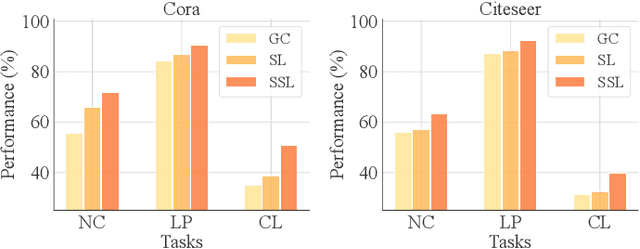
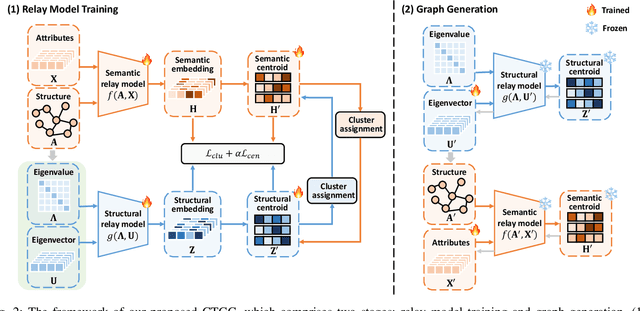
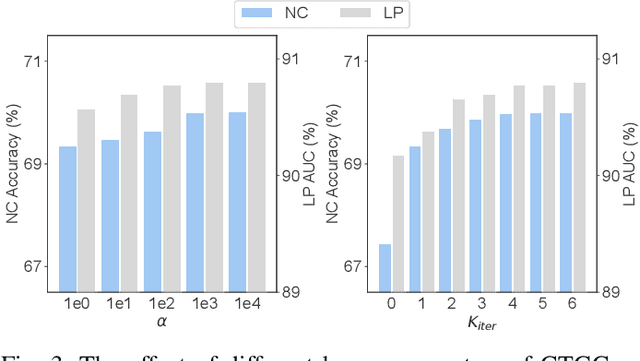

Abstract:With the increasing computation of training graph neural networks (GNNs) on large-scale graphs, graph condensation (GC) has emerged as a promising solution to synthesize a compact, substitute graph of the large-scale original graph for efficient GNN training. However, existing GC methods predominantly employ classification as the surrogate task for optimization, thus excessively relying on node labels and constraining their utility in label-sparsity scenarios. More critically, this surrogate task tends to overfit class-specific information within the condensed graph, consequently restricting the generalization capabilities of GC for other downstream tasks. To address these challenges, we introduce Contrastive Graph Condensation (CTGC), which adopts a self-supervised surrogate task to extract critical, causal information from the original graph and enhance the cross-task generalizability of the condensed graph. Specifically, CTGC employs a dual-branch framework to disentangle the generation of the node attributes and graph structures, where a dedicated structural branch is designed to explicitly encode geometric information through nodes' positional embeddings. By implementing an alternating optimization scheme with contrastive loss terms, CTGC promotes the mutual enhancement of both branches and facilitates high-quality graph generation through the model inversion technique. Extensive experiments demonstrate that CTGC excels in handling various downstream tasks with a limited number of labels, consistently outperforming state-of-the-art GC methods.
Tackling Data Heterogeneity in Federated Time Series Forecasting
Nov 24, 2024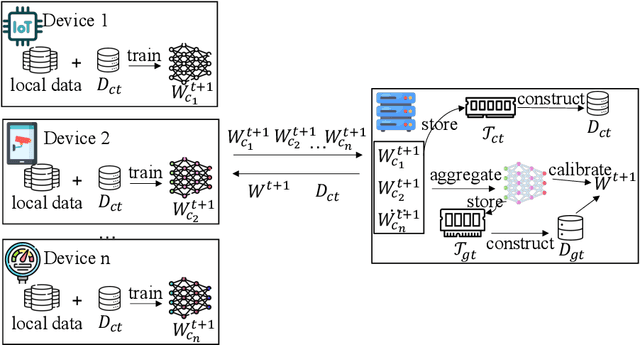

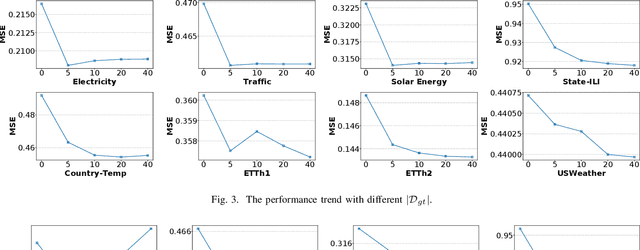

Abstract:Time series forecasting plays a critical role in various real-world applications, including energy consumption prediction, disease transmission monitoring, and weather forecasting. Although substantial progress has been made in time series forecasting, most existing methods rely on a centralized training paradigm, where large amounts of data are collected from distributed devices (e.g., sensors, wearables) to a central cloud server. However, this paradigm has overloaded communication networks and raised privacy concerns. Federated learning, a popular privacy-preserving technique, enables collaborative model training across distributed data sources. However, directly applying federated learning to time series forecasting often yields suboptimal results, as time series data generated by different devices are inherently heterogeneous. In this paper, we propose a novel framework, Fed-TREND, to address data heterogeneity by generating informative synthetic data as auxiliary knowledge carriers. Specifically, Fed-TREND generates two types of synthetic data. The first type of synthetic data captures the representative distribution information from clients' uploaded model updates and enhances clients' local training consensus. The second kind of synthetic data extracts long-term influence insights from global model update trajectories and is used to refine the global model after aggregation. Fed-TREND is compatible with most time series forecasting models and can be seamlessly integrated into existing federated learning frameworks to improve prediction performance. Extensive experiments on eight datasets, using several federated learning baselines and four popular time series forecasting models, demonstrate the effectiveness and generalizability of Fed-TREND.
 Add to Chrome
Add to Chrome Add to Firefox
Add to Firefox Add to Edge
Add to Edge